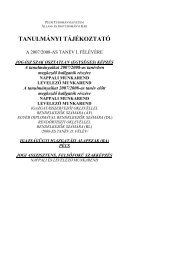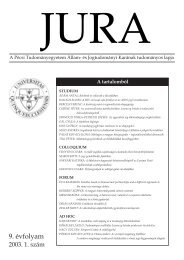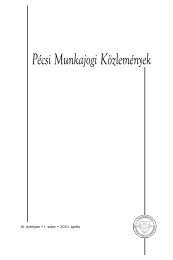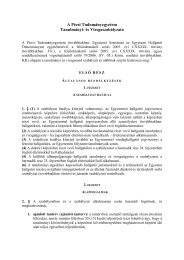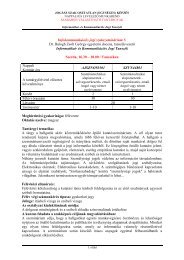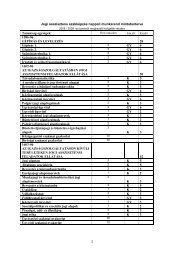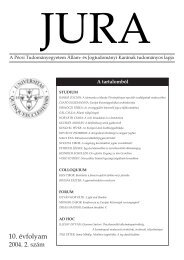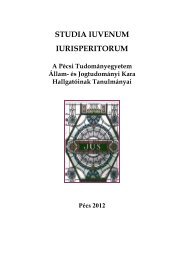2012. évi 2. szám - Jura - Pécsi Tudományegyetem
2012. évi 2. szám - Jura - Pécsi Tudományegyetem
2012. évi 2. szám - Jura - Pécsi Tudományegyetem
- TAGS
- jura
You also want an ePaper? Increase the reach of your titles
YUMPU automatically turns print PDFs into web optimized ePapers that Google loves.
244 Helen Xanthaki: The UK Human Rights Act: a true excuse for judicial lawmaking by the aw Lords?Prof. Helen XanthakiAcademic DirectorSir William Dale CentreIALS (University of London)The UK Human Rights Act:a true excuse for judiciallawmaking by the aw Lords?Introduction: the problem, themethodJudges, especially Supreme Court judges, in the UKare often accused of using the system of precedentand the UK’s loose application of the principle ofseparation of powers in order to make law. Suchstatements are now frequently attributed to thenew and unprecedented opportunities offered tojudges by the HRA 1998 to declare a previous Actincompatible with the Act. 1 But has this new opportunitychanged the approach of judges to statutoryinterpretation, thus leading to an alleged usurpationof the legislative function by an allegedly active UKjudiciary?The essay will attempt to disprove this hypothesisby suggesting that statutory interpretation techniquesremain largely unaffected by the introductionof the HRA. A further analysis of the continuingrestrictions on statutory interpretation juxtaposedwith the new liberties introduced by EU membershipand the HRA will offer an alternative approach tothe debate: the HRA is not the direct culprit, but asignificant contributor, to a recent judicial activismin the field of human rights.Analysisa) Current techniques of statutoryinterpretationIn the UK there never was a sole and unique methodof statutory interpretation. 2 Instead of going downthe comforting certainty of a civil law route ofconcrete, exhaustive, and written [albeit inflexibleand inherently general] compilations of statutoryinterpretation rules, the UK chose the familiar commonlaw route of conventions. As these entered thesystem at various times historically, and were inevitablyattached to specific cases thus being limited byconsiderations of equity and fairness to the specificlitigants, statutory interpretation rules tend to be inexistence in parallel.Historically one can identify the literal, themischief, the Golden, and recently the purposiveapproaches to interpretation. Briefly the literal ruleevident in Sussex Peerage case (1844) 11 Cl & F85; 8 ER 1034 demands that, if the words in an Actare precise and unambiguous, judges must simplyexpound these words in their natural and ordinarysense. As a response to the inequitable decisionsbrought about by the strict application of the literalrule 3 , the mischief rule, evident in Heydon (1854) 3Co.Rep.7a; 76 ER 637, demands that the judge identifiesthe mischief or problem which led to legislativeintervention, identifies the remedy now providedby the law, suppresses anything that would lead tocontinuance of the mischief 4 , and finally advancesthe remedy according to the true intent of the legislator.Of course, the assessment on the true intent andthe true remedy could be undertaken in departurefrom the literal meaning of the text. This could be ofbenefit to a judge trying to avert a judgement thatwould prove inequitable yet religious to the text. Butwould be of danger for the purposes of legal certaintyand legitimacy in the hands of a judge in the habitof missing the boundaries of the three functions ofthe state. And so a combination of the mischief andliteral rule produced the Golden rule, evident in LordAtkinson in Victoria (City) v Bishop of VancouverIsland [1921] AC 384, where the judge declared that...“In the construction of statutes their words mustbe interpreted in their ordinary grammatical sense,unless they be something in the context, or in theobject of the statute in which they occur, or in thecircumstances with reference to which they are used,to show that they were used in a special sense differentfrom their ordinary grammatical sense”. So, whenthe literal rule produces inconsistency or absurdity,the more creative and activist mischief rule can beused to correct the error. But, as stated in the LawCommission’s Report 1969, the subjectivity of what isabsurd and the lack of clear tests for the classificationof a result as absurd rendered the Golden rule lesspopular in the UK compared to other common lawjurisdictions [hence my quote of a Canadian case].In 1993, starting with Pepper v Hart [1993] 1 All ER42 at p.50, senior UK judges introduced the notionof a multi-dimensional interpretation of legislationtaking into account the ordinary meaning of words[so the literal rule considerations]; plus the context,namely the subject-matter, scope, purpose 5 , andbackground of the Act, including Parliamentarydebate as evidenced in Hansard. 6And so the question is whether the current prevalenceof purposive interpretation can be attributed to,JURA 2012/<strong>2.</strong>



